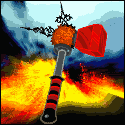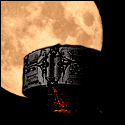|
fatherdog posted:If I were designing 5th edition, I would make 4th, with the following modifications - I would probably approach it like the recent XCOM. One feat tree per class. I might also allow you an additional Feat Tree based on your race, with automatic access to your level 1 feat from both sources. That way your level 1 Human Fighter is still distinct from your Dwarven Fighter, but I could still balance them against each other as they level up. I would also completely silo Combat and Non-Combat, allowing your utility powers to be completely separate from your combat oriented ones.
|
|
|
|

|
| # ? Jun 10, 2024 14:12 |
|
Mendrian posted:I feel like the point of Feats is to create a kind of make-your-own specialty system. Class Features do this already, but the things Class Features let you specialize in are fairly broad - 'Do more damage' versus 'Be more damage resistant', for instance - and those choices are one-time. Feats add a lot of granularity to the class system and hypothetically allow a huge degree of variance between characters. There's room for Feats too, but +1's and 'make my character do what they need to do anyway' selections need to be out of the picture. WOTC also needs to streamline the whole weapon/focus/implement mess.
|
|
|
|
New Legends and Lore. Some highlights: Paladin: For the first time ever, we are giving you the paladin, the anti-paladin, and the warden, all in one package. Those three characters map to good, evil, and neutrality. Ranger: The ranger gains spellcasting at 1st level, marking a bit more of an emphasis on magic in this class than in earlier editions. Math: The math has been overhauled, with character damage dropping. Monster stats are remaining the same, but you might see some monster levels and XP values shifting. More importantly, the martial damage bonus is going away for our weapon-users. Instead, they will gain multiple attacks at higher levels. Fighter: The fighter is getting expertise dice that are spent to gain a bonus to AC or attack rolls, along with other specific abilities. A die spent is gone until the fighter pauses for a moment to rest, with an action spent to rest allowing the fighter to regain a die.
|
|
|
|
You guys like Legends & Lore, right?Legends & Lore posted:Big news this week: We have a new playtest packet coming this Wednesday, March 20th. So, what can you expect to see in the next packet? Let's take a look. In fact, I'm grilling Jeremy Crawford about this stuff as I type this. Didn't read summary: -Druids: stated to match Clerics in terms of healing magic, choose between "spellcasting" and "wild shape" focused builds but all Druids will have some shifting even if it's just utility. -Paladin: stated to come with Good, Neutral, and Evil builds right out of the box called the Cavalier, Warden, and Blackguard. They talk about "the Paladin getting Detect/Smite Evil" though so I don't know how that meshes with, say, Blackguards. In other news, alignment is still dumb. At level 8 they get a mount. They "lack the Fighter's tactical maneuvers" but get spells and an "oath" which provides them with domain specific stuff like Channel Divinity abilities. Since the Next Fighter's tactical maneuvers are garbage this is basically not a big loss. -Rangers: start with spellcasting at level 1, because who even knows. Get favored enemy bonuses again which are supposedly more broadly useful than just some plusses to hit and damage; they mention that taking Dragons as a favored enemy gets you Fear resistance, which can be useful against a bunch of stuff. Rangers do not have any class-specific duel-wielding or archery abilities, they want you to take specialties for that. -Gonna be a bunch more spells for druids and rangers. Oh boy. -Fighters: just gonna quote this again because it says it all: "The fighter is getting expertise dice that are spent to gain a bonus to AC or attack rolls, along with other specific abilities. A die spent is gone until the fighter pauses for a moment to rest, with an action spent to rest allowing the fighter to regain a die." So you can spend expertise dice on cool abilities...oooooor on attack rolls. Also they don't recover until you spend an action to do nothing but rest to recover a single die. -A bunch of poo poo about skills and two-weapon fighting, nobody cares, and exploration rules are actually supposed to be in the new playtest packet this time. e;fb
|
|
|
|
It's actually pretty amazing how methodically my optimism about Next has been stripped away. I was 100% up for a 3e-ish edition that just fixed a few things like caster save target-number fuckery and people needing to choose between taking a +1 to hit and something actually interesting, but this all is just. . .I don't even know.
|
|
|
|
quote:The ranger gains spellcasting at 1st level This is waking up on the bus five stops after I was supposed to get off.
|
|
|
|
Hey, per-encounter expertise dice are much better than per-round expertise dice in terms of being a framework off which you can theoretically hang interesting, meaningful decisions.
|
|
|
|
Kai Tave posted:-Fighters: just gonna quote this again because it says it all: "The fighter is getting expertise dice that are spent to gain a bonus to AC or attack rolls, along with other specific abilities. A die spent is gone until the fighter pauses for a moment to rest, with an action spent to rest allowing the fighter to regain a die." I feel generally positive re: Paladin, Ranger, and Druid stuff, but the proof will be in the pudding. The Warden being a Paladin build is interesting, at least. Good to know the rocket tag mentioned a few posts above may be scaled back. Nonplussed re: extra attacks; I thought we knew better by now.
|
|
|
|
dwarf74 posted:Good to know the rocket tag mentioned a few posts above may be scaled back. I wouldn't be so sure; PC damage is dropping, but monster stats are staying the same. It sounds like monsters are still going to be doing the same kind of damage and fight-ending effects.
|
|
|
|
Ferrinus posted:Hey, per-encounter expertise dice are much better than per-round expertise dice in terms of being a framework off which you can theoretically hang interesting, meaningful decisions. Yeah, as long as this means the effectiveness of these dice is going to get scaled up a bit I'm actually okay with this part. I don't know, actually. Even back in the Bad Old Days I never had a problem with Fighters directly--their big problem for me was the existence of all these other classes that were way more broken-powerful than they were.
|
|
|
|
dwarf74 posted:Nonplussed re: extra attacks; I thought we knew better by now. Roleplaying game designers will never stop trying to work multi-attacks into their games because they've totally got it right this time and multi-attacks will never not be a terrible idea because no, they don't have it right and they will never have it right.
|
|
|
|
dwarf74 posted:The Warden being a Paladin build is interesting, at least. I dunno, it seems like a janky solution to the non-Good Paladin problem. Blackguards being an Evil Paladin build instead of their own class makes perfect sense but tying Paladin neutrality to being a primal nature hippy is strange. How are neutral gods gonna fit into that? Or non-neutral primal spirits? It comes off like a problem-creating solution to something that was hardly a problem in the first place.
|
|
|
|
Misandu posted:I would probably approach it like the recent XCOM. One feat tree per class. I might also allow you an additional Feat Tree based on your race, with automatic access to your level 1 feat from both sources. That way your level 1 Human Fighter is still distinct from your Dwarven Fighter, but I could still balance them against each other as they level up. I would prefer it if feats where about a collection of gimmicky / non-combat stuff. Lots of special talents about how an individual approaches problems rather than more pluses. A tree seems super restrictive and often ends up in a right/wrong way of doing things or a tree that you auto-pick from because its the offensive tree versus the defensive.
|
|
|
Brother Entropy posted:I dunno, it seems like a janky solution to the non-Good Paladin problem. Blackguards being an Evil Paladin build instead of their own class makes perfect sense but tying Paladin neutrality to being a primal nature hippy is strange. How are neutral gods gonna fit into that? Or non-neutral primal spirits? * Do a good thing (correct answer, gives best reward) * Do the good thing but ask for money * Do a stupid and destructively bad thing Therefore, clearly, history will be a long list of the times when Good teamed up with Nature to beat up Evil, only occasionally dimpled by Good and Nature squabbling over logging rights when Evil is rebuilding its armies in Mordor.
|
|
|
|
|
OtspIII posted:It's actually pretty amazing how methodically my optimism about Next has been stripped away. I was 100% up for a 3e-ish edition that just fixed a few things like caster save target-number fuckery and people needing to choose between taking a +1 to hit and something actually interesting, but this all is just. . .I don't even know. That's more or less Fantasycraft, really. Kai Tave posted:Roleplaying game designers will never stop trying to work multi-attacks into their games because they've totally got it right this time and multi-attacks will never not be a terrible idea because no, they don't have it right and they will never have it right. It's not necessarily bad to have multiattacks, I'd say. It's just that you have to understand that, assuming they are based off the most basic attack action, a multiattack will likely be a +100% damage boost per attack. (And on a different note, here's something that came to mind: does anybody know the Etrian Odyssey RPG series? It occurred to me that it'd be a really really good basis for a dungeon crawling game if you wanted something more or less modern for that purpose. The development team actually made a lot of the mistakes we usually rag the D&D designers on for, but they learned to fix them with each subsequent game.)
|
|
|
|
dwarf74 posted:The Warden being a Paladin build is interesting, at least. I disagree with both of these: even most recent RPGs haven't learned their lesson regarding extra attacks (and the one thing worse, Initiative Passes), and there isn't a chance in hell that 5e wouldn't inevitably start walking back to that. The Warden makes no sense to me, because alignment is really loving dumb and I guarantee they'll be stuck to the really stupid version of neutral where you need to "balance" good and evil, randomly attacking both for no reason. So paladins are all super good guys, blackguards are all dumb Bioware "EVUL," and Wardens are schizophrenic.
|
|
|
|
Also, it sounds like they're tying Wardens to nature...mentions of green armor, a stag for a mount...which, okay, the 4E Warden class was a big ol' primal nature-y guy, please ignore the fact that he wasn't a plate-armor wearing mounted knight but whatever...but if that's so then where does that leave someone who wants to play a Paladin of a neutral deity that has nothing to do with being the Green Knight? Like Brother Entropy said, this is a solution to a problem that didn't exist and is now only liable to cause more dumb problems later.
|
|
|
|
I really can't understand how Martial dice keep getting made more and more awful. It's like, all the components are there to make a good, fun system, but they're intentionally making stupid choices. Kai Tave posted:...a solution to a problem that didn't exist and is now only liable to cause more dumb problems later. D&D Next.
|
|
|
|
I thought the martial dice were interesting, especially when I used them as I first thought they were intended - you get to use each die once per round. So there's some tactics involved; if you have three dice, you might use two for extra damage, and save one to reduce damage if you get hit. But apparently they were supposed to be available both on your turn (for attack) and on each of the enemies' turns (for damage reduction), which I thought was a bit overpowered. But now they've gone entirely the other way and completely nerfed them. Welp.
|
|
|
OtspIII posted:Yeah, as long as this means the effectiveness of these dice is going to get scaled up a bit I'm actually okay with this part. The thing they described is basically ho Warblades from Tome of Battle worked, except that instead of regaining uses of trip attacks or piddly bonuses to AC, Warblades were regaining cool, flavorful maneuver slots. It means you've set the granularity of "things Expertise Dice can do" to be roughly equal to "get an extra action", otherwise spending an action to regain them is meaningless. So it's not a bad idea, but unless it's step one of completely overhauling the Fighter class, it's a bad idea.
|
|
|
|
|
Old Kentucky Shark posted:The thing they described is basically ho Warblades from Tome of Battle worked, except that instead of regaining uses of trip attacks or piddly bonuses to AC, Warblades were regaining cool, flavorful maneuver slots. It means you've set the granularity of "things Expertise Dice can do" to be roughly equal to "get an extra action", otherwise spending an action to regain them is meaningless. Except that this is not even true. Warblades recovered ALL of their maneuvers with one swift action that had to follow either doing nothing or hitting a guy in the face with an attack. I mean, forget 4e, there's already a 3e class that does everything the Next Fighter wants to do, but better.
|
|
|
|
It will come down to numbers, really. If a fighter will be able to pull an interesting maneuver every round and not run out of dice before the end of the fight (which should be three-four rounds according to what the devs are aiming for) then his dice-regaining mechanic will be a non-issue. If he has to blow all his dice in one go in order to do a cool attack, and then spend the rest of the combat doing nothing, then it will be
|
|
|
|
Aren't they divorcing the dice from maneuvers? Which, given how bad the maneuvers were before they came up with the dice mechanic, is troubling in itself.
|
|
|
|
Kai Tave posted:Roleplaying game designers will never stop trying to work multi-attacks into their games because they've totally got it right this time and multi-attacks will never not be a terrible idea because no, they don't have it right and they will never have it right. Going back to this for a sec, didn't 2E have a multiattack thing as you leveled up, with Fighers and Paladins and the like? I don't remember hearing too many complaints about that implementation, was it shoddy too?
|
|
|
|
I think it had some weird "get an extra attack every other round" rule in order to curb the sudden spike of damage output between levels, which was then translated to "get a crappy attack that you can use every round (you don't move) that never actually hits anything" for 3rd ED. I could be mistaken about the 2E thing though.
|
|
|
|
Brother Entropy posted:Going back to this for a sec, didn't 2E have a multiattack thing as you leveled up, with Fighers and Paladins and the like? I don't remember hearing too many complaints about that implementation, was it shoddy too? It was fine when used as intended, but largely because everything else was so easy to track.
|
|
|
|
2e had everyone do one attack per round except the warrior classes, who gained half an attack every I think 7 levels, read as 3/2 attacks, which more or less meant "round one attack once, round two attack twice," and then full on became two attacks per round. You could add to this with weapon mastery if you were a fighter, and ONLY a fighter. Fighters in AD&D 2e or AD&D UA were beasts of destruction. Certain ranged weapons automatically attacked more often (or less often for crossbows), like bows I think just plain started off with two attacks per round, and the ALMIGHTY DARTS were three per round, which bizarrely made them the weapon of choice for cheesy fighters and wizards - the former could pound a bunch of static damage increases to become a dart machine gun, the latter having two extra chances to roll the 20 it needed to hit. Mind you, these attacks were not in any way limited. It wasn't "you attack for -6 attack bonus," it wasn't "you have to make a full attack." It was just "Oh yeah and when you shank a guy, you do it twice." The only limitation was that you can only move half your movement rating and still melee attack, with ranged being more heavily penalized for moving. A human has a movement rating of 12. That means a human fighter can move - not charge, just normal movement - 60 feet and still unleash 2-3 attacks in one turn. Fighters in AD&D 2e and AD&D UA were beasts of destruction. Oh yeah, and as for escaping melee, you had two choices. Withdraw meant you could only move 1/3rd your movement, so good luck there, unless you have a buddy also fighting this dude who can harry him and keep him in place. Or you could flat out flee an retreat and use your whole movement. Which means your enemy gets a free attack on you. All his attacks on you. Not costing him anything. Really, this sorta eats at why D&D Next is having so many problems. It's not 4e. It's 3e. 3e is and always has been the really, really bizarre one. It's why martial die change every other test run - because the 3e crowd is used to really weak fighters who don't contribute much and have easily bypassed AC and no defenses against magic, whereas everyone else other then hardcore AD&D no supplements players are used to fighters being uncomplicated badasses who have incredible saving throws, super high HP values, armor that makes them all but invincible against melee attacks, and soul crushing attacks that massacre everything in their path and let none pass by them. In my experience in 2e at least, Fighters don't tend to worry about the cleric healing, because the cleric is healing the other poor saps who aren't wearing their incredible plate mail and shield, and who don't have a nice big buffer of HP between living and dying. When people say Fighters in AD&D weren't defenders, they are correct. Fighters didn't have one role in combat, because they did just about all of it. So in D&D Next you have a problem. The developers have stated they want AD&D/3e style fighters back. No powers, not ToB style maneuvers, just attack, defend, and occasionally something like trip. And if they truly brought in the 2e style monstrosity of a Fighter, that would more or less be ok. Boring, since the skill system hurts fighters for no reason other then "3e developers really loving hated fighters," but do-able. The problem is that the 3e fanbase does not want monster fighters, so they call fighters who take little damage and vomit forth death as overpowered. And that, too, would work, if they gave fighters something more then just "kill a thing." But they can't. So they're stuck with a fighter that must be about and only about "kill a thing," but cannot be very skilled at it for fear of overshadowing the rest of the party. Incidentally while looking some of this up, I encountered this in the 2e book. And I quote: quote:layer characters have a marvelous (and, to the DM, vastly amusing) tendency to fall off things, generally from great heights and almost always onto hard surfaces. While the falling is harmless, the abrupt stop at the end tends to cause damage. 3e is and always has been the bizarre aberration.
|
|
|
|
Mikan posted:Fighter: The fighter is getting expertise dice that are spent to gain a bonus to AC or attack rolls, along with other specific abilities. A die spent is gone until the fighter pauses for a moment to rest, with an action spent to rest allowing the fighter to regain a die. So why is it that Expertise Dice seem to get nerfed every single new playtest round/L&L/update? How much longer until the fighter is just a literal reprint of the 3.X version of the class?
|
|
|
|
Having the dice available each turn was not overpowered. Having recently played the game, allow me to offer this: All of the maneuvers that aren't 'do more damage' are sort of dumb. The only reason I even used my 'Protect Others' power is because it didn't consume my Martial Die for the purposes of dealing more damage. I prevented 2 damage out of the roughly 30 that was dealt to the whole party. If I'd had to choose between 'prevent between 1 and 6 damage' and 'kill this thing, thus preventing a hypothetically unlimited amount of damage', guess which I would choose?
|
|
|
|
ProfessorCirno posted:Fighters in AD&D 2e and AD&D UA were beasts of destruction.
|
|
|
|
FRINGE posted:2e (at least up to ~level 12 or so which was about were our games seemed to find their natural retirement) generally remained fun for both wizards and fighters. Rogues were the class that struggled unless the player just loved their RP, or the specific game was built to ensure their useful place. Rogues have always had a weird place in D&D. If one's in your party the DM feels compelled to add sympathy traps, except then it really sucks when the rogue missed on his roll and get slammed by an acid spray or lightning bolt for rolling poorly, maybe even catching multiple people in the blast. If there's no rogue, well, traps may as well not exist for the most part (unless your DM hates you).
|
|
|
|
Mage Hand as a cantrip also takes care of a lot of the more basic rogue/thief stuff. "Okay, Zaggar uses Mage Hand to open the chest. Whoa, poison darts! Good job we were all 50' away behind this pillar." (RAW says Push/Drag/Lift is 5x Carry, so by rules lawyering Mage Hand can move up to 50lbs, which is pretty useful unless a suspicious chest lid or door is made of solid lead.)
|
|
|
|
PeterWeller posted:I'm relying on the rules that appear in the same books that you're talking about. And I'm not talking about playing murderhobos in Planescape. That's your own strawman. You can have a campaign that features a lot of combat without it being a murderhobo campaign. Planescape centers on a giant, sprawling, corrupt and decadent metropolis at the center of the universe; if you don't think that location supports getting into all kinds of fights, I don't know what to tell you. I've played in two Planescape campaigns. One was all about gatecrashing and kicking rear end. The other was about intrigue between the factions and stopping planar conspiracies. Both started out with us troubleshooting local problems in our chosen neck of Sigil, and both involved a good amount of fighting. Also, choose between say or insinuate; a book can't do both at once. Kai Tave posted:Roleplaying game designers will never stop trying to work multi-attacks into their games because they've totally got it right this time and multi-attacks will never not be a terrible idea because no, they don't have it right and they will never have it right. Mikan posted:It works in Dungeon World because that's how the entire game is structured, and it's smart enough to include ranges like "close" and "near" and "far". The moves are all written around the concept. MadScientistWorking fucked around with this message at 00:58 on Mar 19, 2013 |
|
|
|
It wasn't a particularly deep conspiracy, just your standard "Yugoloths are trying to start a large scale faction war so they can..." I don't remember their motivation. We just fought, magicked, searched, and tricked our way from one thread to another like you would in any other D&D campaign involving secret bad guys. AD&D wasn't the best set of rules for that sort of game, sure, but outside of fights, we only paid token attention to the AD&D rules. We got into around two to three fights a session in that campaign, generally against random planar monsters and thugs involved with the conspiracy on some level. The finale involved fighting through various faction dudes to confront the ultrademon pretending to be a faction delegate in a classic "stop the assassin at the summit" plot.
|
|
|
|
PeterWeller posted:outside of fights, we only paid token attention to the AD&D rules.
|
|
|
|
FRINGE posted:This was our normal behavior as well. (Of course exceptions existed, but exceptions are exceptions.) In my experience, this is normal behavior for almost everyone who started on Basic and moved to AD&D. It's also a reasonable explanation of why so many people look back fondly on AD&D, because if you try playing it rules-as-written, most of the suck (and there's lots) is noncombat stuff. It did have one reasonably good noncombat thing. Secondary skills. You pick from this list of stuff that you used to be before your were an adventurer, and then it's implied that you can be reasnably successful at stuff that would relate to it. If you were a farmer (for instance) you can be expected to know how to handle animals, how to build basic stuff, how to butcher animals, plan out crop fields, know about wolves and other stuff that might gently caress your animals up, etc. There's no dice rolling, just "yeah you know all this stuff from your pre-adventuring days". I still like AD&D though. Elector_Nerdlingen fucked around with this message at 01:54 on Mar 19, 2013 |
|
|
|
AD&D 2E had non-weapon proficiencies, and importantly, warriors got more of them than wizards or priests.
|
|
|
|
PeterWeller posted:AD&D 2E had non-weapon proficiencies, and importantly, warriors got more of them than wizards or priests. Would you mind elaborating? I never played AD&D and this sounds pretty interesting.
|
|
|
|
The Sin of Onan posted:Would you mind elaborating? I never played AD&D and this sounds pretty interesting. You got a certain number of "slots" for non-weapon proficiences at first level, and then gained more as you gained levels. The initial number was based on your class. Almost all of the "kits" in the "Complete X" series of books involved giving you bonus non-weapon proficiencies in addition to their other benefits. The proficiencies were associated with an attribute, and generally listed a number of things the proficiency allowed you to do with a "proficiency check", which meant applying a modifier to the associated skill and then rolling under that number on a d20. One of my favorite non-weapon proficiency related anecdotes involved the hunting skill. If you used it, the DM was supposed to roll a 10d100 to determine how many yards you were from prey, and then each successful proficiency check allowed you to get a specific number of yards closer to it (I want to say 100) without spooking it. The idea was that you would be able to close to decent bow range and be able to snipe a deer or something. The associated ability was Wisdom. I was playing in a campaign that had no rangers, but two Paladins. Out in the wilderness and low on food, one of them realized that he had the hunting proficiency, and an 18 Wisdom. So he proceeded to hunt deer with a broadsword.
|
|
|
|

|
| # ? Jun 10, 2024 14:12 |
|
The Sin of Onan posted:Would you mind elaborating? I never played AD&D and this sounds pretty interesting. First of all, I was wrong. Priests and wizards did get one more initial slot than warriors. But basically, they were like the secondary skills previously mentioned split into five categories: warrior, wizard, priest, rogue, and general. You got a number of initial slots with which to purchase proficiencies. They usually cost one slot, but if you chose a proficiency from outside your class and the general category, it cost one extra slot, sort of like 3E's cross class skills.
|
|
|










































